FUTURE growth
A new agriculture education center takes shape at LBCC
BEYOND THE CLASSROOM
with Mark Urista

ARTIST SPOTLIGHT
with Alora Thomas

A new agriculture education center takes shape at LBCC
BEYOND THE CLASSROOM
with Mark Urista

ARTIST SPOTLIGHT
with Alora Thomas

March is finally here and spring has almost sprung. I’m hoping we start to get less rain and more sunshine this month. As much as I love the rain, the winter months can be rather dreary and gray. The sunshine of March helps motivate me to finish the term strong and go into finals with a little more confidence and optimism. We’re almost at the end of Winter term Roadrunners. Let's finish strong!
When I think of March, I think of growth. Spring is beginning, so all the greenery of Oregon is starting to come back to life. We have to go through those cold gray days to get to the brighter ones. This idea can be taken literally or as a reflection of one’s personal growth. There are a lot of different people with different backgrounds that make up the LBCC community. Whether you are struggling through a busy term, dealing with personal challenges, or having difficulties supporting yourself and your family, the hard days are what make the light at the end of the tunnel worth pursuing. Working through our dreary days is how we grow. Nothing worth doing is easy. College is an amazing place because every student is here because they’re going somewhere. They’re here to learn and grow. To take their career,
and their life, to new horizons. So, if you feel discouraged and burnt out, think about how far you’ve come and where you’re going; these are the moments that make you.
The Commuter team has been continuing the trend of growth. We’ve continued to hire more students onto our team and the number of contributors is going up as well. For March we went for a longer edition with a few extra pages because we simply have too many stories to pack into the magazine. One of my goals this year has been to get more of the LBCC community involved with the Commuter, so I want to reach out to all our readers and encourage you all to drop us a line. If you’ve got anything at all you want to share, shoot us an email and get in touch. The Commuter is for the students, by the students.
I wish you all the best of luck on your finals, and I hope you all have a relaxing spring break. See you next term, Roadrunners!
Ryan Janowitz Editor-in-Chiefthe Commuter is the student-run magazine for LBCC, financed by student fees and advertising. Opinions expressed in The Commuter do not necessarily reflect those of the LBCC administration, faculty and students of LBCC. Editorials, columns, letters, and cartoons reflect the opinions of the authors. LBCC is an equal opportunity educator and employer.
The Commuter encourages readers to use its “Opinion” section to express their views on campus, community, regional and national issues. The Commuter attempts to print all submissions received, but reserves the right to edit for grammar, length, libel, privacy concerns and taste. Opinions expressed by letter submitters do not represent the views of the Commuter staff or the College.
wanna get together? We’re really nice and fairly cool and we’d love to hear what you have to say. Not big on journalism but love to journal? Perfect. Are you a STEM major with major opinions? Let’s hear ’em. Like writing about ’80s film? Local animals? Snack hacks? Maybe you have a hefty folder of flash fiction on your laptop, just dying to be published and printed. Drop us a line. We’d love to meet you, read you, and support you. Think your ideas might be too weird or too niche for submission? Even better. The Commuter is an awardwinning publication because of our wide range of contributions and our unique contributors. So reach out. We’ll be staring at our email inbox in the meantime, not an ounce of chill to be had.
cover photo by SARAH ROSE LARSONPHOTO



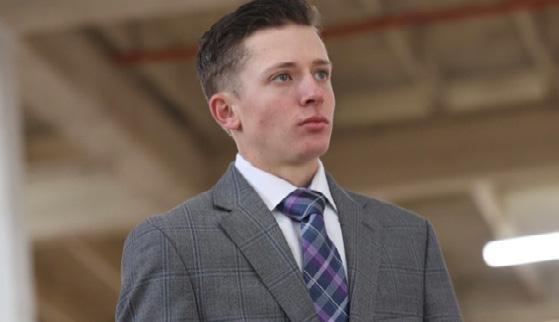








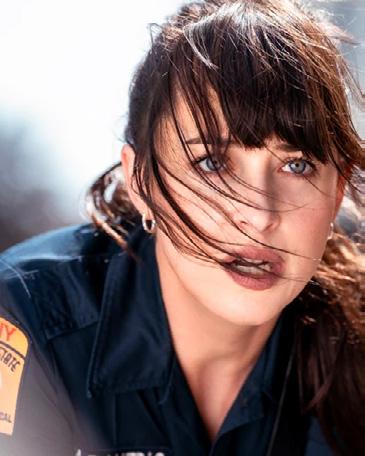
What do you do at LBCC and in your professional career?
I am one of two full-time Speech Communication faculty members at LBCC. I teach Public Speaking and Argument and Critical Discourse. I also advise the Civil Discourse Program and co-lead LBCC’s Cornerstone Project and Heterodox Academy Campus Community.
Why did you choose teaching?
When I was in college I knew I wanted to do something that involved working with people, particularly helping young people struggling to improve their lives. I had been thinking about counseling or something in law and advocacy. At a summer barbecue during my junior year, my debate coach laid out a compelling case for why I would be a great community college instructor and shared the steps I would need to take to become one. I decided to achieve that goal and have never regretted my decision.
How has your upbringing affected your teaching and outlook on life today?
I think most professionals are heavily influenced by their life experiences. I was a total screw-up in high school and dropped out when I was 17. After living on my own for a few years, I was forced to mature and take responsibility for my decisions and actions. There were a few moments during that period where I hit what felt like rock bottom. Each time, I looked myself in the mirror and asked, “Mark, what role did you play in creating this situation?” As tempting as it was to blame someone else or some system, I knew the truth was that I had the most influence in shaping where I was and how I was feeling. Once I made the decision to hold myself accountable, my life began to change for the better. I still have this mindset today and encourage my students to practice it as well.
You mentioned that you dropped out of high school. What made you enroll in El Camino Community College?
I was playing video games with a buddy. At some point, he looked at the clock and said something like, “Oh shit, I’m supposed to register for classes at El Camino right now.” I

drove with him to the college, took a placement test that I was unprepared for, and signed up for two classes.
What do you do outside of being a communications professor and advisor for the Civil Discourse Program?
I hang out with my wife and daughter who's about to turn four years old. The weekends totally belong to them. We enjoy working on house projects and spending time outdoors. Having quality one-on-one time with each of them is very important to me. I’m always on the lookout for fun daddy-anddaughter dates. My wife and I don’t get much time alone but when we do, we enjoy going for walks at Bald Hill or watching something on Netflix together.
What are some memorable times when you impacted your students?
There’s no specific instance that stands out to me. Usually, it's a really good debate that happens in class and an open discussion afterward where students speak honestly and authentically. It’s also enjoyable to watch a student who's been struggling or has been quiet all term dominate an assignment and speak in a way that captivates the entire class. Knowing that I played a role in shaping the conditions that contributed to these successes is gratifying. Has there been an impactful event or experience that changed your life’s trajectory?
I’ve thought about this quite a bit, and aside from my buddy driving me to the placement test at El Camino, there isn't one moment that stands out. There are, however, a collection of sequential moments. Looking back, if any of them had not occurred, it could have totally shifted the path that I was on.
My first term at El Camino, I was enrolled in English Composition and First Aid. About halfway through the term, I dislocated my knee. Before the injury, I had missed several assignments in my writing class because I just wasn't doing the work. But now that I was stuck at home and unable to do my job at a sports bar, I had plenty of time and a little more motivation to complete the assignments. I ended up barely passing the writing class with a C. In my first aid class, I had done enough where I was on the
cusp of earning a C or B. The teacher told me on the final day that if I were willing to play the role of a victim as all of the students came in for their tests, he would bump me up to a B. I thought it was so cool that I could be an actor pretending to have some kind of condition to get a better grade, that it made me want to sign up for more classes the next term.
All of these little moments added up and provided me with momentum. Once I was ready to immerse myself in the college experience, I discovered a ridiculous amount of opportunities to get involved with high-quality programs. I did a couple of one-act plays with El Camino’s theater department, joined student government, and became a competitive member of the college’s nationally ranked speech and debate team. Each activity helped me become a more engaged student, significantly contributed to my development, and oriented my life toward a purpose-driven future.
Do you have any role models or people you look up to?
Yeah, there's two in particular. The first is Edward McCrary III, a psychology professor I took a class with when I was 20 years old. Over the years we developed a dialogical relationship similar to the one Will and Sean have in one of my favorite movies, Good Will Hunting. I could be honest and vulnerable with him. Despite our generational and racial differences, we shared an intellectual connection and similar outlook on what constitutes a good life. Prof. McCrary was not only a mentor, but a good friend and dare I say a father figure. Usually, when I had gaps between classes, I would visit him to banter or grapple with political and philosophical subjects. But I think what made him an incredibly impactful role model was that he had high standards of excellence that forced me to work harder than I ever had as a student. I remember the first day of his class, he said that his psychology course transferred directly to UCLA and that he was going to be teaching the class at the same standard and with the same rigor that UCLA has. Several classmates were intimidated by that, but I loved the challenge. Also, I thought it showed a lot of respect for his students because he believed we were all capable of reaching that standard. I remember earning C’s on some of his tests early on in the term and
being incredibly frustrated. I thought, “No, I'm putting in all this time and effort I should be getting a higher score.” When I talked to him, he just looked at me and said, “You need to study harder and you need to study better.” And then he pointed me in the direction of resources trusting I could figure it out what needed to be done. This forced me to be disciplined, creative, and resilient in a way nothing else had ever had.
Throughout my K-12 experiences, it felt like I was just checking boxes in this cookie cutter one size fits all system that apparently was supposed to make you educated. Professor McCrary’s class made me focus on improving weaknesses I had in life and helped me appreciate that education is not just about earning a degree so you can go out and get a job. It's an opportunity to participate in something that is transformational, that changes who you are for the better. It's kind of like someone who realizes they're undisciplined and disorganized, so they join the military for structure. His class was kind of like my boot camp: I was someone who was pretty immature and had trouble fulfilling basic responsibilities when I started. I left as a person who was goal-oriented with a strong locus of control.
The other professor who had a huge impact on me was Dr. Mark Crossman. He was my speech and debate coach and the first professional who seemed like the older version of the person I was striving to become. Mark invited me to try out for the forensics team, an experience that totally transformed my life because it got me into a group with a number of highly successful individuals who had concrete goals; something I didn't have at the time. At that point in my life, I had learned a very important lesson: the people you spend the most time with are going to heavily influence how you think and behave. Mark created a program with high standards and a collection of diverse students who were competitive and willing to do whatever it took to help each other succeed. He also created an environment that was a lot of fun to be a part of.
You mentioned the debate team. Why did you join that and when did that occur in your college career?
Well, I've always been intrigued by what back in my day we called social studies. I also
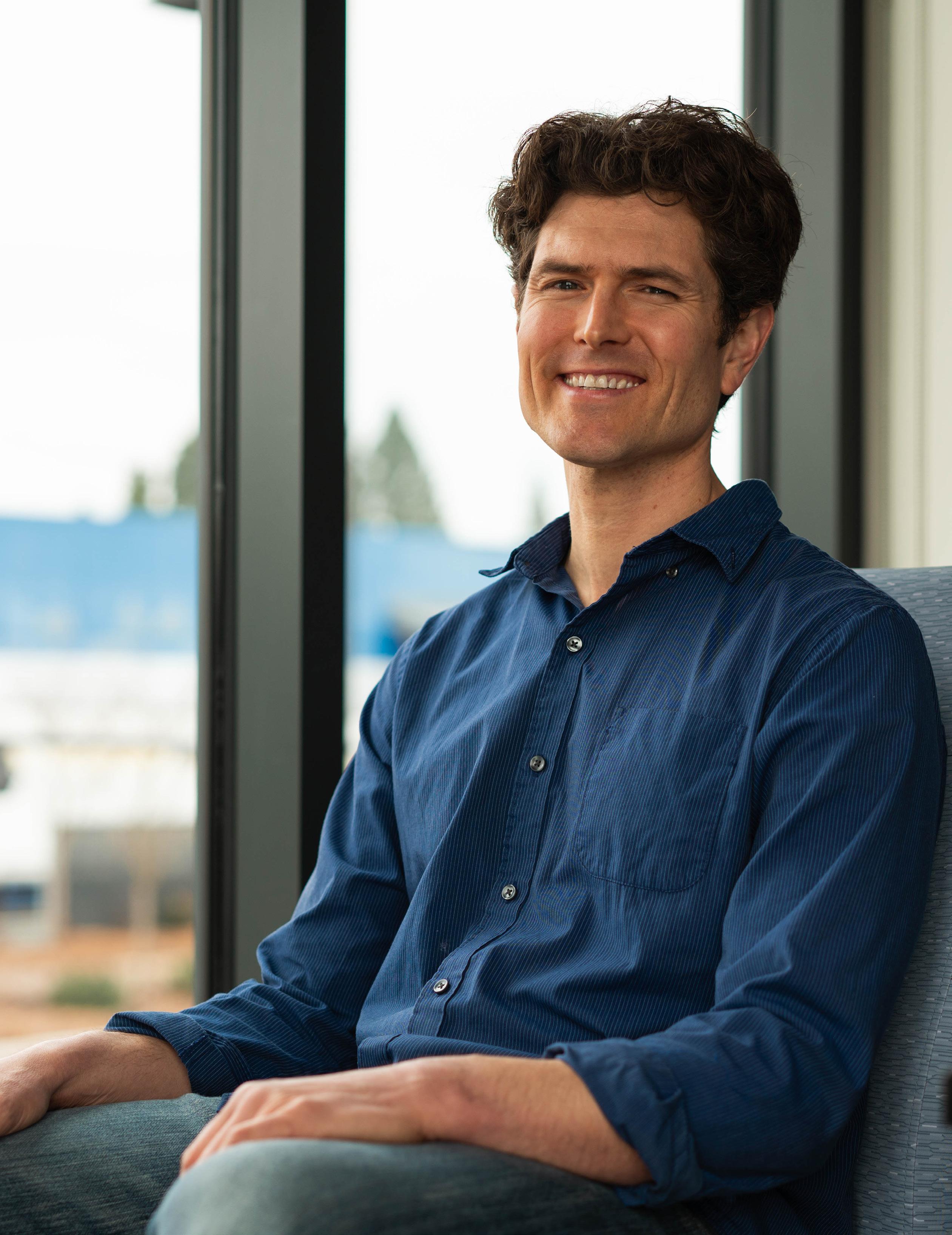



grew up in a household with a Republican father and a Democrat mother who often argued about politics. Most people who know me well will tell you that I’m not afraid to share my opinion and enjoy thinking deeply about complex challenges. The speech and debate team provided an ideal extracurricular activity that both suited my interests and helped me develop my talents. The team gave me opportunities to participate in tournaments with students from other colleges and universities in the greater Los Angeles area. Some of those experiences completely transformed how I viewed myself as a person and student. I remember my first term, my partner and I went up against a team from UCLA and beat them. Remember, I'm a high school dropout at this time. So the fact that we went to a college debate tournament and defeated two UCLA students was incredibly empowering for my self-concept. My selfworth shot up as a student and I realized, you know, I think I can actually be highly successful in academia.
What about after El Camino Community College, where did you go and what made you want to take those steps?
I transferred to UC Berkeley. One of the reasons why I transferred to Cal was because I was intrigued by the challenge. Berkeley has the reputation of being an incredibly competitive school with a long, rich tradition of excellence. I also liked the fact that it was in Northern California. NorCal and Southern California might as well be different states. They're culturally very different. As someone who was born and raised in Los Angeles, I wanted to escape the environment I had spent most of my life in and try something new.
You often mention your love for Community College, why do you view it in such a positive light?
I absolutely loved being at El Camino. It’s a community college that serves as a hub for the greater Los Angeles area. I had classmates from the inner city, the barrio, the beach cities, and wealthy areas. Being in a classroom with this kind of diversity and discussing a social problem like poverty created a fascinating environment that challenged my perceptions and helped me gain a deep appreciation for viewpoint diversity. It made me realize that community colleges are incredibly unique because they have a student body composition that more accurately represents society than what you’d find at other colleges and universities. As a teacher, I take advantage of that. The classroom provides a special and precious context where people who normally would never come into contact with each
other can start to discuss and understand different perspectives about complex topics and issues.
Community colleges also allow students and teachers to develop a relationship with each other that is challenging to create in a university setting, like OSU. Many professors at universities need to focus on research. They don't have much time to devote themselves to the growth and development of undergrads, even though some may genuinely want to. Fortunately, at a community college, our primary responsibilities involve working directly with students and being excellent teachers in the classroom. My classes are capped at 20 students and I know each of their names. There's no way I could be the kind of teacher I am if I were in a forum with 100 plus students and depended on graduate students to work directly with students.
You have a fellowship at UC Berkeley, do you mind elaborating on that?
UC Berkeley’s Greater Good Science Center uses evidence-based practices to produce wellness in society. One specific program they have is called Bridging Differences that focuses on improving the ability to have civil discourse and to develop healthy relationships between people who are ideological opposites. The center’s director learned about our Civil Discourse Program and invited me to participate in a projectbased cohort where I'm now creating a playbook for our co-curricular program. It will provide more information to students and employees at LBCC and can also be used by faculty and staff at other colleges who want to develop similar programs.
You do a lot outside of just being a professor, what keeps you passionate about the communications field and civil discourse field?
This work is a labor of love. When I see results, when I see wins, when I see students thriving, that fuels me and makes me want to see more. That's just my personality. I have a lot of energy and am driven to achieve.
Would you like to share anything else?
I deeply believe that education is something that's supposed to be personal and transformational. I was incredibly blessed to have a community college in my hometown that provided students with educational experiences that rival what less accessible colleges and universities offer. It seems harder for community college students to have these experiences today. However, it’s not impossible. Seize the opportunities that are currently available. If they don’t exist, then get to work building them.

On January 5, just moments after takeoff, a cabin door panel blew off in midair during an Alaska Airlines flight from Portland to Ontario, California. After investigation it was determined it was mostly likely due to manufacture or installation flaws.
Accidents like these are supposed to be prevented by a thorough process called non-destructive testing.
LBCC is home to Oregon’s only twoyear NDT program. Scott Ballard was hired in the summer of 2016 to help launch the program. He works with instructors Zachary Milligan and Emily Whittier who have 35 years experience between the two of them. Together they guide students to their Level 1 certificates in NDT.
Non-destructive testing is a crucial part of today's quality inspection process used on many products around the world. NDT is used to inspect and evaluate materials, components, or assemblies without destroying their serviceability. This includes testing on aerospace products, nuclear components, and products made with exotic metals such as titanium, zirconium and tungsten. NDT ensures the safety of a wide array of products from airplanes to children's toys. The demand for workers in the field is high
and LBCC has been producing efficiently educated and trained workers in their NDT program since 2016.
Along with the schooling, through the Cooperative Work Experience program, students can move up to Level 2 or Level 3 technician. The program works closely with the metal and component manufacturers in Albany. ATI, Pacific Cast Technologies, Selmet, and Ti Squared Technologies are all companies where students get on the job experience through CWE.
According to Scott Ballard, the job market for program graduates is very strong with 100% employment after completion of the program.
With the experience and schooling gained from the program, graduates often earn full-time employment from those local companies or those similar to them around the world. Graduates of the LBCC program are also often interviewed by the Navy shipyard in Bremerton, Washington.
Former student Mason Wakefield completed the program in the spring of 2023. He switched from engineering after taking the intro NDT course and got on at ATI through CWE. He now works fulltime at ATI in Albany “The program gives you the classroom knowledge and handson experience that gives you a head start on the job. I would highly recommend at least
trying NDT 100 if you're interested. It can lead to a great career and it's a lot of fun.”
The NDT associate of applied science degree is earned with 91 credits and is broken up over 6 terms with around 15 credits per term. This includes classes and training in ultrasonic phase array 3D imaging, radiography, penetrating dyes, magnetic particle inspection, and visual inspection to find surface and subsurface flaws.
Before 2020, the program was full and had to turn students away, but the numbers decreased drastically after the COVID pandemic started. Now numbers are just about to what they were before and the program is thriving.
“Our goal is to fill the program and I believe next year's incoming class will be at maximum capacity!” Ballard said.
Freshman A.J. Talsma said he heard about the opportunity in high school from a friend who planned on doing the same thing. He is interested in the career opportunities the program has to offer and has enjoyed it so far.
“The instructors are great,” Talsma said. “They provide assistance wherever you need it. They have also brought in guest speakers who have provided great insight into what the industry is like.”
 words and photos by SARAH ROSE LARSON
words and photos by SARAH ROSE LARSON
Nestled someday soon among grass seed farms of the Willamette Valley, a brand-new Agriculture Education Center is the focus of a new chapter being written for agricultural education at LBCC.
Linn-Benton Community College is moving forward with construction of the Agriculture Education Center, made possible by $16 million in funding. It represents a significant investment in agricultural education at Linn-Benton and Oregon's agricultural industry. The new center, located half a mile south of the Albany campus on Looney Lane, will replace LBCC's current aging and cramped facilities.
The Agriculture Education Center will include a new animal science classroom with wet lab, a significantly larger indoor arena, student lounge area, and a 40-stall horse barn with runs. In addition to these upgraded facilities, it will have cattle, sheep, and swine barns.
“This (current) facility is just way too small, so we only have one species of livestock,” said Jenny Strooband, department chair of Agricultural Sciences.
Dr. Chris Wickcliffe of Cascadia Equine had originally purchased the land on Looney Lane to establish and grow his own equine center. According to LBCC Foundation Director Steven Broncheau, Wickliffe offered to sell the property to LBCC in 2019. The college’s staff and administration already had hopes of
building a new ag center and the property fit well with that dream.
“It kind of fell into our lap,” Strooband said.
To purchase the property, the college went through a grant process from the state. This resulted in $8 million from the state to go toward the property. To receive grants like this, community colleges have to match the funds, meaning Linn-Benton needed to find another $8 million.
“Community colleges in Oregon take turns to ask for stateappropriate funds for construction, and in 2019 when LBCC's opportunity to apply opened up, the college submitted a request for $8 million in state appropriation funds,” said Broncheau.
Linn and Benton County voters approved a $16 million bond earmarking the matching $8 million, with the rest going to Periwinkle Childcare Development Center and improvements to other college facilities.
“With amazing community support from the 2022 bond election, we are able to expand our programming and services,” said Linn-Benton President Lisa Avery.
The Animal Science Department was one of the first departments at the college when it opened in the 1960s. It has never had a lab to study cattle, sheep, and swine.
“My colleagues have spent all these years having to travel from farm to farm to farm to farm and make use of other people's livestock, which is really hard,” Strooband said.
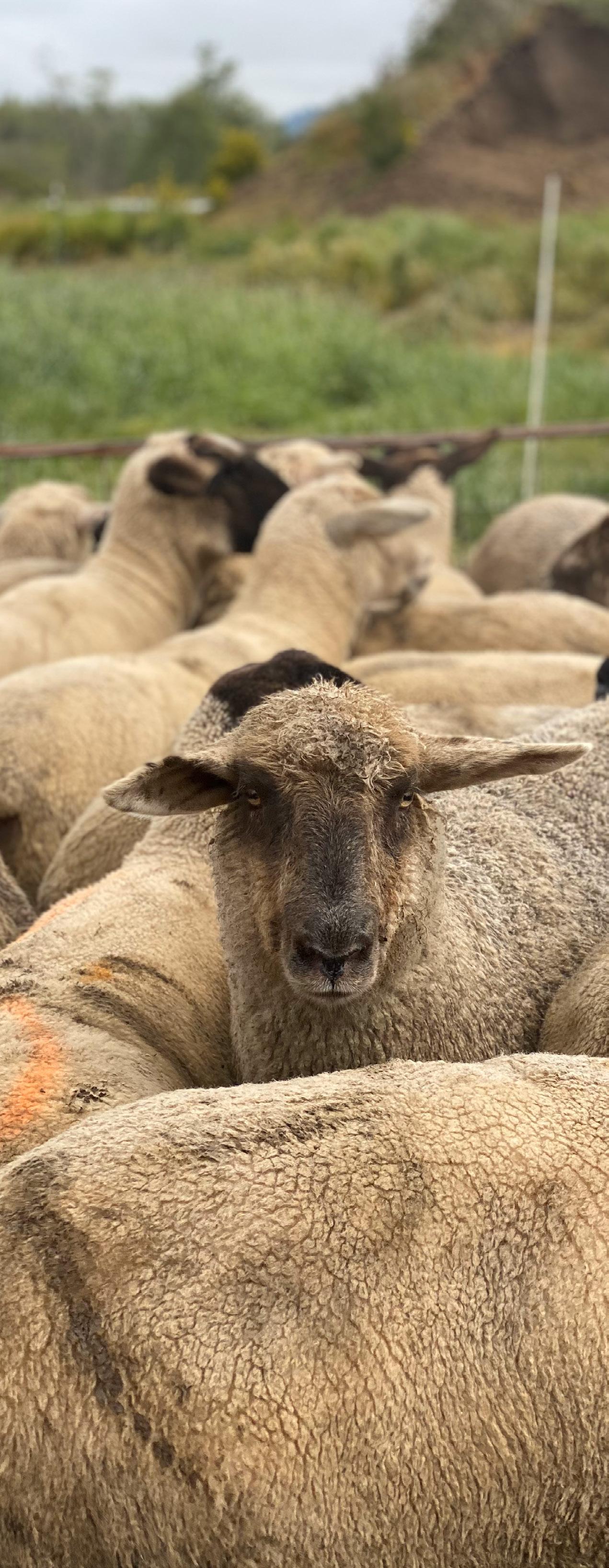
The lack of prolonged observation for students also has been limiting.
“For 60 years, we've been offering these classes without any on-site laboratory. And it's just really hard to offer the education that students need,” she said.
The opportunity to grow additional programs within the department is not guaranteed, but the college hopes to add areas of study.
Currently, the equine program uses a state-of-the-art ultrasound machine in their horse breeding program and is wellequipped to provide competitive education for students.
“All of our processes right now use the best technology that's available,” Strooband said. “But as we expand, we would really like to integrate some green agriculture techniques, specifically like micro irrigation, GPS farming, using drones for assessing crops, that kind of thing.”
Funding for the project only covers building and permit costs. The money necessary for rolling out new programs, “depends on what programs the college is able to fund,” Strooband said. The footprint of the buildings will take up about 9 acres, which will leave another 46 acres for farmland.
“We are really hopeful that we can bring back a crop science program,” Strooband said. Until 2018, Linn-Benton offered horticulture.
“It’s a great opportunity to develop and grow forages, grass, and crops. Especially in this area, it's a huge part of our industry. It seems like we're not really serving the community as well as we could be in that regard. And that's definitely the feedback we're getting from our advisory committee.“
A crop science program would be added to the list of transfer degrees LBCC is or will be offering. Strooband and her department are also working with the veterinary school at Oregon State on a veterinary technology degree. This would add to the current Horse Management program and an Associate of Science Equine Science degree.
“The ag center will not be competing with OSU, " said Broncheau, “Rather it will be complimenting and fulfilling a need for two-year ag degrees, the vet tech program being one of the new programs LBCC will offer.”
The architects have completed building designs for the new ag center; permitting is underway, and the challenging process of ground prep is next.
“It's going to be an expensive area to build in just because of the amount of moisture. We're looking at probably a million and a half dollars just in rock,” Strooband said.
LBCC's current agricultural center resides at the end of 53rd Avenue in Albany, less than two miles from campus. After the recent ice and snowstorm, a new facility can’t come soon enough. Maintaining the stables and health of the horses boarded there became even more challenging than usual for staff and students.
“I mean, honestly, it's just a hard facility to work in,” Strooband said. “It is old, and it is underwater. We had to make a new fake manure pile here because our manure pile was super icy for five days, and now it's underwater.”
After the program moves, the property located on 53rd will be sold. The Albany City Council recently approved annexation for the property along with others throughout the city’s boundaries, 13 in total.
Neighbors in the area, however, expressed concern over plans
to partially zone the property for single-family homes.
In a letter to the city council and published in the Albany Democrat Herald, neighbor Deborah Hughes said, “This potentially could lead to the development of traditional farmland and would greatly impact the traffic patterns on 53rd Avenue, surrounding farms, wildlife habitat and wetlands.”
“There's so much wetland on this property, I think it'd be really hard to develop,” Strooband responded. It is unlikely any new construction would be possible in the waterlogged area, she said.
Faculty in the department hope to see groundbreaking occur later this summer, or early fall. In her 22nd year at LBCC, Strooband is optimistic the ag center can open in fall 2025, earlier than some members of administration predict.
“I don't know how realistic that is,” she said.
“It's just really, really hard. It’s time to start investing. We've been here a long time. We've been patient.”
Plans for the new ag center extend beyond the classroom.
“This is a place where it's not just going to be for the school, but it is going to be for the whole community,” said LB’s Vice President for Finance and Operations Sheldon Flom.
Strooband also looks forward to the potential for the community.
“One of the main reasons that we wanted to develop the center is because we really want to have a place where we can invite youth into our facilities, specifically 4H groups, Oregon Sustainable Agriculture Land Trust, and then FFA groups. These programs include thousands and thousands of kids in Oregon. We think that that outreach is going to be really helpful in not just our recruiting efforts, which are important, but also the growth of agriculture in general in Oregon.”
Avery agreed: “One element I am most proud of is the way we will be able to partner with additional local businesses and organizations to host community events at the center. Through this visibility, we expect to draw increased enrollment and additional financial support from our sponsors.”
But growing a new generation of local farmers might be more

difficult than at first glance.
“Oregon farmers are getting up there. The average age is around 63,” Strooband said. “That's really concerning. Agriculture is the second-largest industry in Oregon. It's a really big part of our state economy, and we need to make sure that we're educating students in the field of ag.
“Agriculture is the number-one economic product of Linn County. I think that the college realizes that the majority of its residents really would like to see more of an agricultural sciences presence in the area. We are living in a farm county. Benton County is a farm county, too,” she said.
“Our agriculture faculty and staff, as well as our community advisory board, are helping with the building plans and are excited to make it a student-friendly space, as well as a great home for our growing livestock."




Travis Overvig's story is one of resilience, dedication, and a relentless pursuit of growth. A high school graduate of 2010, Travis entered the workforce, gaining valuable life experience in various blue-collar jobs He co-founded "Overvig Trucking" with his brother, demonstrating early on his entrepreneurial spirit and commitment to hard work.
With a loving wife and four children by his side, Travis decided to redefine his future by pursuing higher education. This decision brought him from Southern Oregon to the Willamette Valley, where he enrolled at LB As a non-traditional student, Travis brings a unique perspective to the student body, understanding the challenges and aspirations of those who take unconventional paths
Initially joining the SLC's Judiciary Board for his second year, Travis’s potential was quickly recognized, leading to encouragement to apply for the Vice President role. His tenure as VP since last spring has been marked by significant growth and leadership. He has adeptly led the SLC's Judiciary Board and has stepped in for the SLC President when needed
A natural supporter and listener, Travis has been instrumental in assisting his teammates, whether in SLC tasks or offering a listening ear. His advocacy extends beyond the campus as well. He has made multiple trips to the Oregon Capitol, providing personal testimonies on student financial challenges and advocating for the Oregon Opportunity Grant
Travis's ambitions as SLC President are rooted in his own experiences He is deeply committed to tackling tuition hikes, advocating for student affordability, and addressing food insecurities through his continued work on the Affordability Committee. He understands firsthand the financial struggles students face and is dedicated to making a tangible difference.
Could you tell me a bit about yourself and why you decided to major in Agricultural Sciences?
Yeah, so originally I’m from Livermore, California. The main reason I came to LinnBenton was for the livestock judging team. Once I got a scholarship and decided to come here I then talked to my advisor, Clay Weber, about some fields that I should probably get into. After figuring out what degrees were offered, I thought Ag Science was the most broad range so I could maybe get into fertilizer sales or feed sales, something along those lines. I think Ag Science was just the best major that had the most broad spectrum for me at the time.

What are your plans for after LBCC?
After LB I actually have a couple opportunities at senior colleges to judge livestock again under scholarship. A couple of them are Arkansas, Chico State, University of NebraskaLincoln, Auburn, and West Texas are all options that have reached out to me through livestock judging and stuff like that. So that’s probably what I’ll do and I’ll continue with Ag Science and go from there. With getting a degree in Ag Science, I hope to get into a career dealing with the sales of fertilizer, seed or livestock feed. Also there is a chance of finding a job as a farm manager with this said degree.
Did you grow up showing animals in 4H?
When I got into high school I started raising animals through FFA at the high school level. I raised pigs and sheep and then did livestock judging my junior and senior year. Then I ended up winning the State of California (judging contest) in 2022, and that’s how I got the opportunity here at LBCC.
Could you tell me more about the livestock judging team?
Yeah so, right now we have six sophomores and eight freshmen. The sophomores go on trips throughout the year. So far, we’ve been to Kansas City, Louisville, Amarillo,
Texas, and Denver, Colorado, and then tomorrow actually we’re leaving for San Antonio, Texas. Our final one is going to be Huston, Texas. On these trips, we compete in competitions called livestock judging contests, and at the contests we evaluate breeding and market animals in 12 different classes. In each class, there’s four market or four breeding animals that consist of either cattle, sheep, goats, or pigs, and we’ll rank them one through four. After we’re done judging, we give what’s called a “set of reasons” on eight of those classes, and you basically go up to an official judge and explain in your own words why you placed the class that way and how they got deemed their position in that class. It’s all scored out of fifty points for each class and each set of reasons. What have you enjoyed most about the Agricultural Science program and judging livestock?
I love how small the classes are sometimes and how interconnected everyone is, because everyone has the same goal and we’re all there to learn. Everyone likes to help each other out and be friendly. And that goes right into the livestock judging team. Along with all the fun trips we get to go on and all the different livestock and places we get to explore and see, I wouldn’t trade my group of friends from that team for anything. They support me and we support each other about everything in life. It’s kind of crazy that judging livestock has brought me some friends that I’ll probably have for the rest of my life. What has been the most challenging part?
The most challenging part is probably going on these trips and then having to catch up with class and schoolwork after that, because it’s hard to get it done while you’re gone and working on reasons and judging livestock. So it’s just hard to knit in school along with it. But a lot of teachers on campus are normally very cool about it, they understand it's classified as a school sport and most are really flexible. There’s always a couple each term that says we have to drop the class, or things like that, but we’re starting to figure out who those teachers are and which ones not to take for which term.
Is there anything else you’d want people to know that I didn’t ask?
If you haven’t explored the agriculture field or agriculture department here at LBCC, I encourage it because it’s such a great program. I know there’s not a ton of students in the agriculture department, but the more that get into it the better. My coach Sierra Meyers and our assistant coach Jared Wolf, along with Clay Weber, are always welcoming to new students who want to try out new things.
So, what's your major and why did you decide to study at LBCC?
Originally my major was criminal justice. But through the avenue of getting involved with the civil discourse program, I've actually decided to change my major. Here at LBCC, it's not a big thing major-wise because you're doing a lot of two-year programs. It's like a focus but it's not really major. However, when I go to Western Oregon, I will have changed my major to communications. That's kind of where I've landed with my two years here: Linn-Benton, I started at criminal justice and have kind of moved into the field of communications.
How did you decide on communications?
There were a lot of factors. One of the things was I found myself really gravitating towards the field. I've taken every communications class here at Linn-Benton, and it was never, “I have to take communications,” it was always, “Yes, I have another communications class! Let's do it.” That was one of the big things, but also Mark Urista, our faculty advisor for the civil discourse program, played a big role in that because he teaches Comm 114. He talked to me about the program. He expressed interest in seeing if I'd want to join, and I did join and I loved it. I've had a really good time meeting everyone in the program; new and who was already there. Overall, I think I chose communications because that's just where I feel like I fit in. With criminal justice, I had always felt like a placeholder and never felt like it was me, but communications is me. That's awesome. What are your hobbies or interests outside of school?
Great question. I'm a big gamer. I really like to play any type of game: board games, card games, video games. Heck, I'll play kick the can. That has always been a passion of mine. Within the last couple of years, I actually picked up another hobby because of a job I had as a cake decorator. So, that started as a job and moved into a hobby of mine that I love. Unfortunately though, I don't have some of the tools right now. I'm broke and all that stuff. So hopefully eventually I can get back into doing that. Are you involved with any other clubs or organizations that LBCC?
I’m very involved with Cornerstone. Cornerstone is this program that we're trying to help build and implement in the LBCC classrooms that is trying to help students basically learn and understand how to read and process what we call transformative texts. So, that would be things like Letter from Birmingham Jail by Martin
Luther King Jr. or Aristotle's rhetoric on communication. It's essentially these informative, transformative texts that have shaped me in a big way. Something about our society that still affects us today. I got involved in Cornerstone when I stumbled my way into one of the classes with that deal Morales, one of the writing professors, and from there, it just kind of snowballed. I started taking other Cornerstone classes. I really liked the direction they were going with teaching us about that stuff. And eventually, I just kind of became involved as a student in the program, helping the professors kind of understand what they could do to help students better understand what the program is, and better implement that in the classrooms.
It's really interesting. It's something I would suggest if every student could check it out they should because one of the things is, after you complete three classes of Cornerstone courses, then you get what's called a Liberal Arts Award. That's an official award that can go on your resume. And it’s also a lot of the classes you already need to take. So, Communications 111, Writing 121, and a bunch of humanities classes. These are already classes you're gonna have to take.
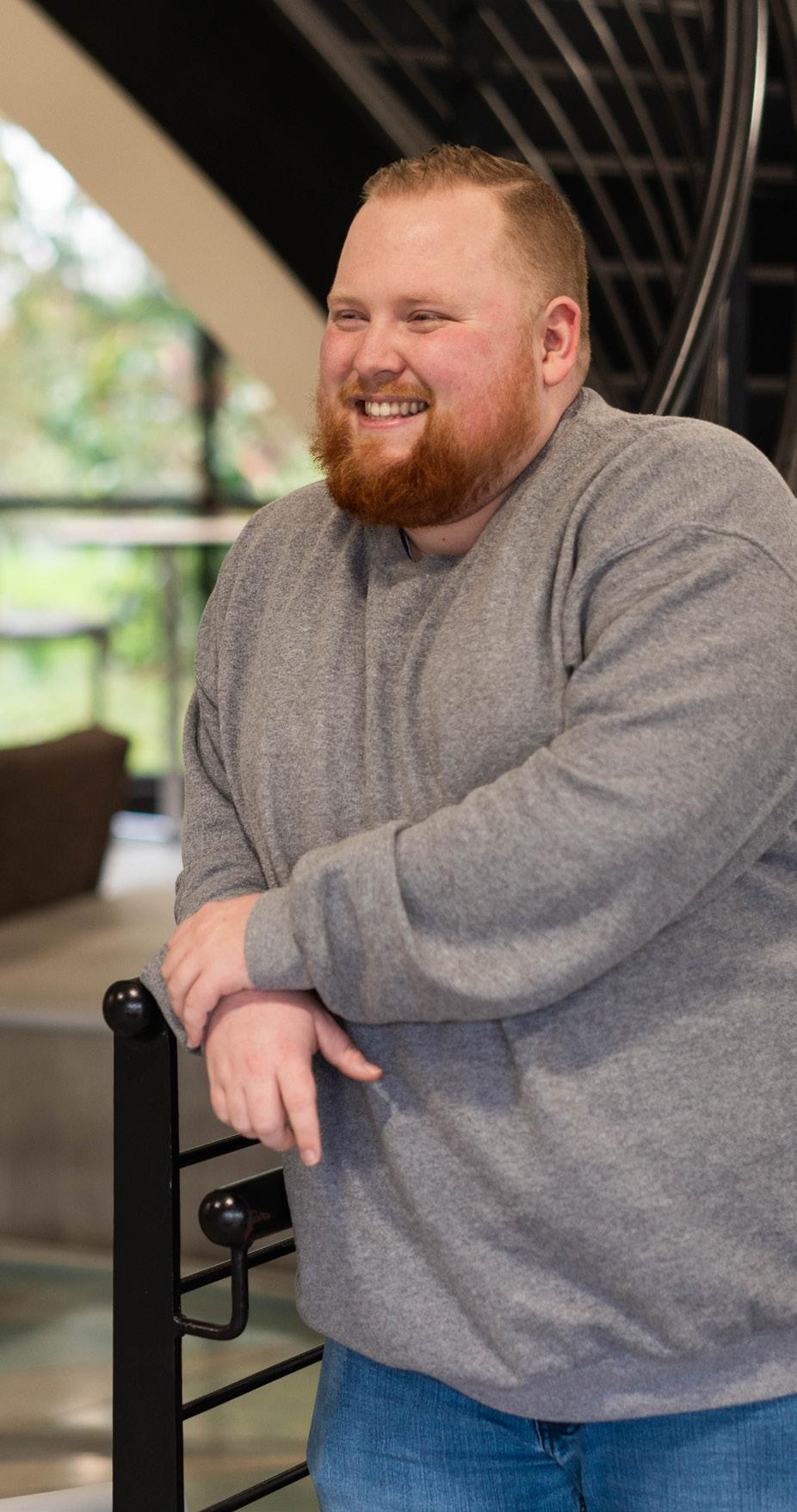
Why not take Cornerstone classes? Then at the end of those three classes, you get something to help build a resume. That's kind of my thought process with it. And then that kind of really just snowballed, and I ended up taking four because I liked them so much. So that's just something that I've really enjoyed doing and helping hopefully get that implemented better here at LB and then maybe in the future, helping get it implemented at another school or something like maybe Western Oregon.
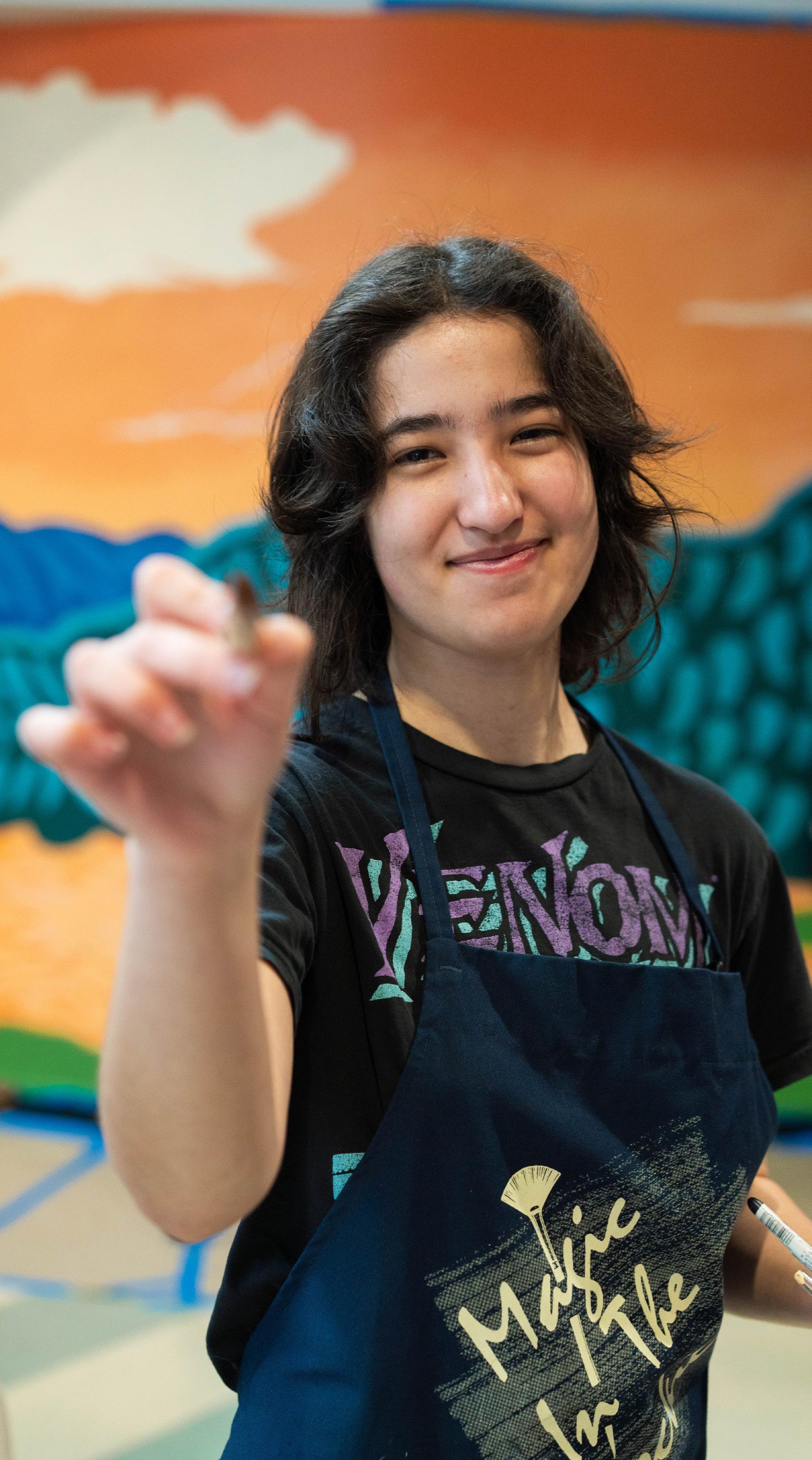
What is your major?
I am majoring in the visual communications degree track, essentially graphic design. This is my first year here. Just came out of high school.
I heard some of the art that you created over Christmas break might reflect a bit of your journey?
Anne (Magratten) had asked me to make some stuff for The Commuter. And I wasn't actually too sure what I should make. I'm striving to be a concept artist. So I took that as a way to actually get some reference sheets done that I've been needing to do for a very long time, which are sheets that portray the design and expressions of a character. I did two of those, and they're both kind of in an art style that I would use more for rigging, so like symmetrical compared to being more loose. What first inspired you to be a concept artist?
I always drew a lot when I was a kid. I've seen so many pieces of paper that have been shoved into a box for years. But the thing that really pushed me to character design and the concept of building a character from basically nothing was my friends because they were into things like Littlest Pet Shop or My Little Pony, and they would make their own figures. I always thought that that was super cool. And because I was their friend, they always tried to bring me into it.
So we would make these worlds with these characters, and we would play them out with the little figurines. That grew into a love of making characters and giving them their own reality.
How would you describe the ability to create a reality and then step into it?
I think it allows us a reminder to just be creative and open. I think it's something that I also have heavily relied on many times in my life, in a sense that the inspiration for creating something can come from anything.
It could come from simple things I enjoy,


like just a random flower I see out on the side of the road. It could be that maybe I'm not feeling very happy or very ecstatic that day, so I take that emotion and turn it into something else so that I can help figure it out, to communicate it between me and the art. But then there's also just a sense of making something to have fun and to do a lot more storytelling setup.
You can take anything from the things that you can see, the things that you can feel, the things that you can hear, and you can make it into something, put it into a sense where it's a world that you yourself could have a deeper connection to, or it could be something that has no meaning or connection.
Can you introduce the rough sheets included in The Commuter this month?
OK, the one in the red dress is one of the very first characters I ever owned. And they have come a very, very, very long way in terms of design.
They originally started out as a catgirl, who then I would just completely threw out the window, and I was like, "You're gonna be a fire nymph." And the ears on her head aren't ears at all, they're just stone. Her whole hair is stone. I wanted to play on the idea of lava and the sense of it burning super hot and super bright and then it becoming molten and then just becoming completely black and cracked on the surface, but it could still be warm underneath.
She's not angry or very emotional, she’s very cool and calm, but when she gets mad, it becomes that fire. I kind
of wanted her to seem like she could be approachable. She's very kind, very sweet, but she does look more like she has a higher status look, but she doesn't necessarily come from a high-status life. She is praised by the people in her town because she will come by and basically burn their fields, which then creates a better environment for more growth for their farms.
She just feels very grateful to the town because they took her in when she was young. And she grew up alongside a lot of them. So when she found out she could help them in this sense, she wanted to do that.
Does she have a name?
Her name is Lolik. I have searched the world. I have no idea what it means in the slightest.
How did you come up with it?
Her original name was Lolo, and I hated that. So I just put an “I” where there once was an “O.” Yeah. Called it good.
The other one I think, has six arms, two on the back of her head, two as normal arms. No one else is going to have six arms. Her name is Ita.
She's actually inspired by a dream I had. This is actually very common for me. I will randomly just wake up after being asleep and be like, “I gotta write that down.” Because I will have seen this character and they'll do something or like the whole dream will be centered around them. And I'm like, “This is something that I could work with.”

I got her design in my head, and it just stayed there because I thought it was very cool. I wanted to give her a more Greek and Roman feel, hence her outfit.
I kind of wanted her to be like a mythological monster because the hands behind the head really kind of reminded me of gorgons, basically, Medusa. The streaks in the hair and the hands reminded me a lot of that. I love Greek and Roman mythology and love to look at the statues and read the mythology. I really wanted to work on a body type for her that you would see on a statue from that time and just play around with it and have fun with her.



Oh, and just do gork 'cause monsters are fun. What advice would you give someone who's just starting out in building characters?
Just do it. Honestly, I have plenty of characters who I have made from elementary school, middle school, high school, and even just last year that I turn around and look at and go, what was I thinking when I made you? Why
do you look like that? Why do you have five belts that you're never gonna use? What is this hairstyle? Why did I choose these colors?

And you know what? It's OK to think that way. But at the time, you gotta remember, you genuinely enjoyed that character when you made it. And as you further your progress along and you further your ability to make designs and further your interest of what you like in designs, you can look back at those characters, you can take them, and you can go, “You know what? You need to be fixed.” Then you can take them, and you can evolve their journey while you yourself progress as well.
There are definitely characters that I've looked back on, and I think that they're awful and that I probably should never have created them. But the minute I redesign them, I feel so much better. I feel like I can really make them work and that they can continue their story. So don't ever be afraid or worried about how they might look, or what somebody's going to say about them, or if nobody's going to think that they're cool or not, they will be. Because all
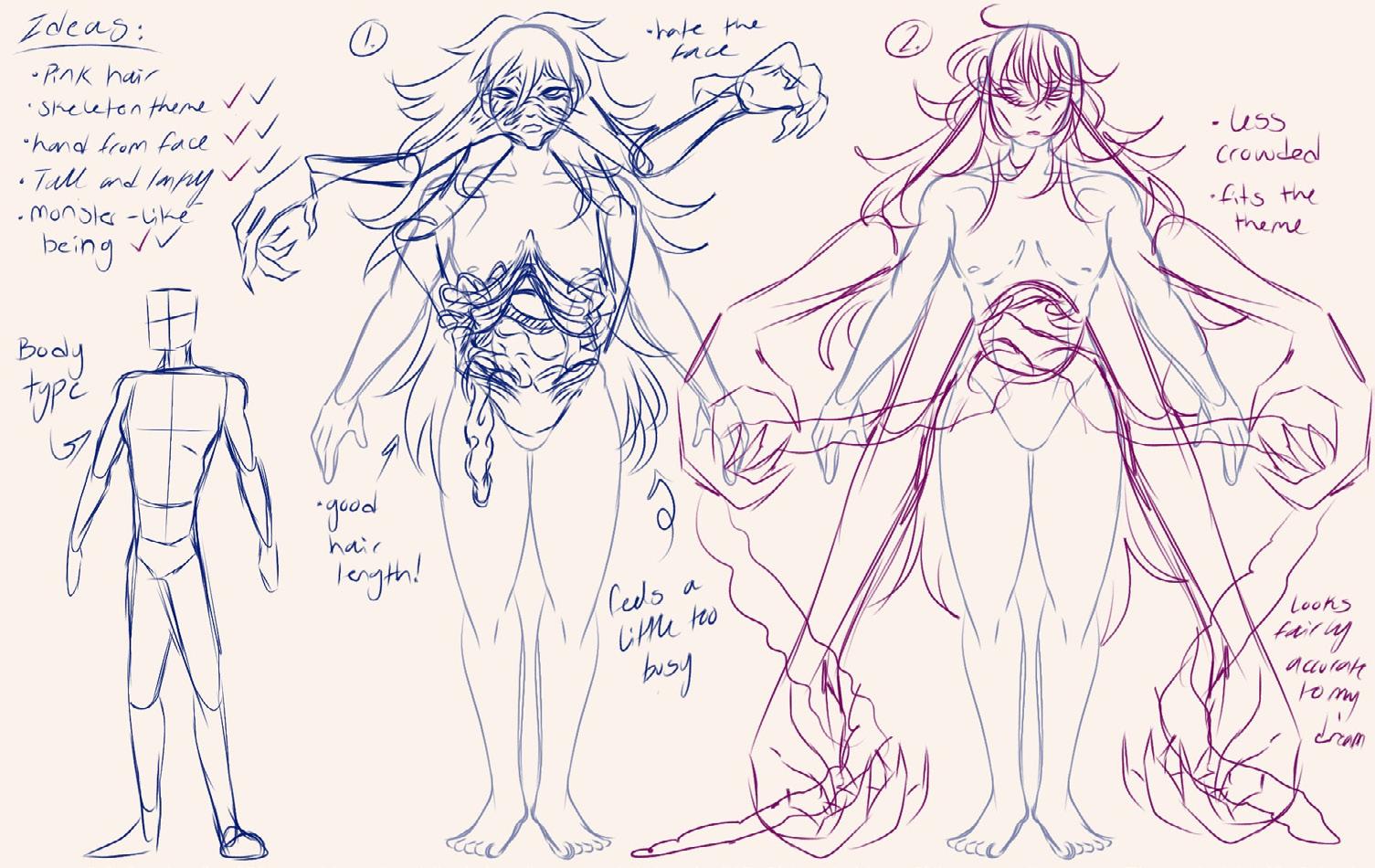 @Shrine_Doodles
@Shrine_Doodles
that matters is that you like them and that you can always advance them along further as you yourself progress.
If someone is not an art major and maybe they don't feel artistic but they have some electives coming up, what kind of art classes do you think might be great for them to still try out?
Definitely take a basic art class. It's a great way to kind of pick up on your own style but also participate in practicing multiple styles.
You'll learn a lot of important techniques that you do not necessarily have to use. But it's a good way to get started. They tend to be a bit more simple. But then after that, if you still wanted to go after something, go for the next class up, like another drawing class, maybe taking a figure drawing class. If you wanted to go more towards a bit more realism or had an interest in learning more anatomy, maybe a basic painting class.
I was that kid who just hopped around from class to class. The minute I finished my basic design class, I threw myself into jewelry, which I had never done before, but it was fun.
Whether you want to take that and do it for the rest of your life does not matter. If you feel like it is something that you have an interest in, that you might want to even slightly hop in for yourself, take it, and have fun with it. Learn a new skill, learn a new hobby because it makes you happy.
What are some of your big dreams?
I would love to make it on television. Not in a sense me, but my characters. I would love to just have at least one character. I wouldn't even be upset if they were a side character shown for two seconds on the screen. I would celebrate.
I just want to put my characters out there, and I want people to connect to them. I want kids to feel inspired by the things that they do. I want teenagers to feel like they could have a connector that they can connect to. I want adults to feel like they're characters that they can sit down and watch. I want people to be able to enjoy the art that I want to provide to them.
And it doesn't have to be everyone. It doesn't have to be all at once or all of the time. I just want to give people the same feeling that I got when I was first inspired and moved by characters. I want them to find a connection in a community, whether it's with themselves or with others, through the designs I make. Is there anything else that you'd like people to know?
I suppose the only thing I would say is don't give up.
Small things happen at small times as our changes occur. Eventually, things will come more and more together, the more and more you learn and the more and more that you find styles that you like. Always try to find an interest in learning new styles. It's good to branch out. Don't ever feel like you have to stay stuck to one style for consistency reasons.
Just be open and free.
Student mental well-being is at an all-time low according to national surveys. Some 60-80% of all college students reported feeling overwhelming anxiety in the past year. Around half said loneliness and depression caused them real trouble.
What’s up? Some factors: The pandemic and its aftermath disrupted learning, social relationships, financial security, and a feeling of safety and predictability. Tech and the 24/7 world takes a toll, too. We get less sleep than past generations, and on-line everything disrupts social connections.
The future is as always uncertain, but seems especially scary lately. Anxiety wants life to be predictable, and it’s not.
If you are suffering, you’ve never been less alone in that feeling. But historically, we’ve never felt more lonely. What can help?
Connect: Attend events. Talk to your classmates! Check out the LB website for more info on clubs and events.
Take time: Make sleep, nutrition, exercise, and social connection a priority. Visit the Wellness Room to relax, do yoga, meditate, or use the massage chair.
Reach out: The Advising Center offers free short-term and crisis counseling during school hours, or call the LBCC Mental Health Crisis Line at 541-917-4666 anytime. Not ready to talk? Reliable online resources can be a good place to start: Mayo or Cleveland Clinic, NAMI (the national organization on mental illness), or the Anxiety and Depression Association of America.
Check back here: Check the print Commuter for monthly Roadrunner Wellness stories. Online Wellness Wednesday columns run weekly.
Ask questions! Email to svobodj@linnbenton.edu with the subject line: Ask A Therapist if you’d like your question answered in a future column.
graphic via FREEPIK
▲ This assignment took me to downtown Corvallis where I found myself in the presence of two masters of their craft.
First stop was Sedlak's Boot and Shoe repair on Southwest second Street between Jefferson and Madison Avenue. Head straight through to the back door and you'll find Greg Goff. Welcoming but quiet with his hat low, and his head down, he is fully engaged in his work.
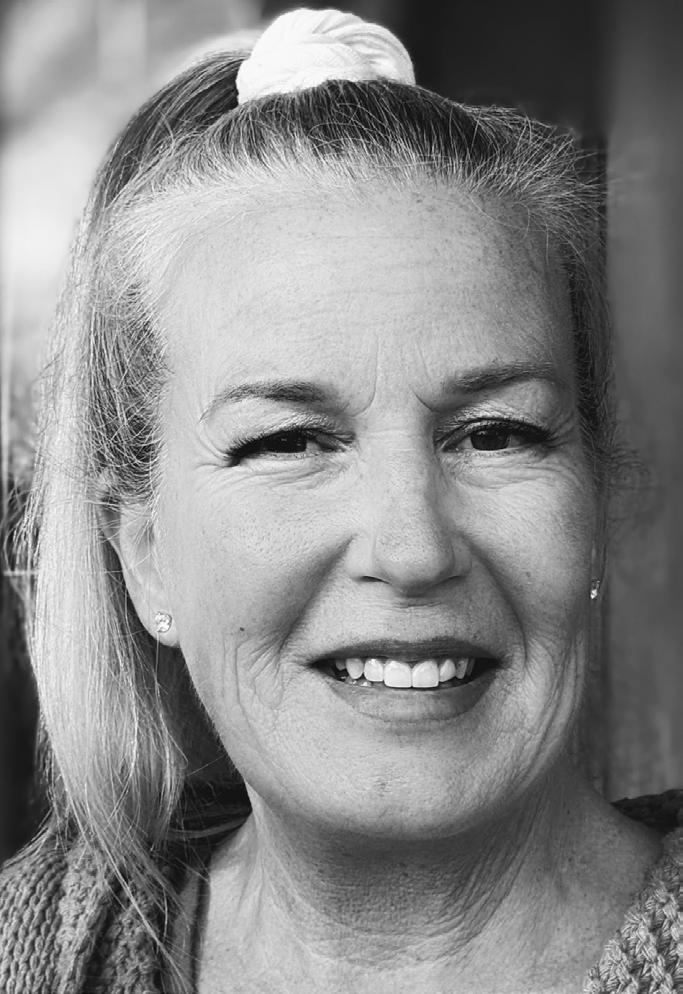
He is the manager of the repair department at Sedlack's and has been a cobbler for the last 29 years. Though he really enjoys his work as a cobbler, in an earlier life he would have liked to have been a saddle maker, though he decided against it because it would have meant relocating and he's grown to love where he lives.
My next stop brought me to Corvallis Cyclery

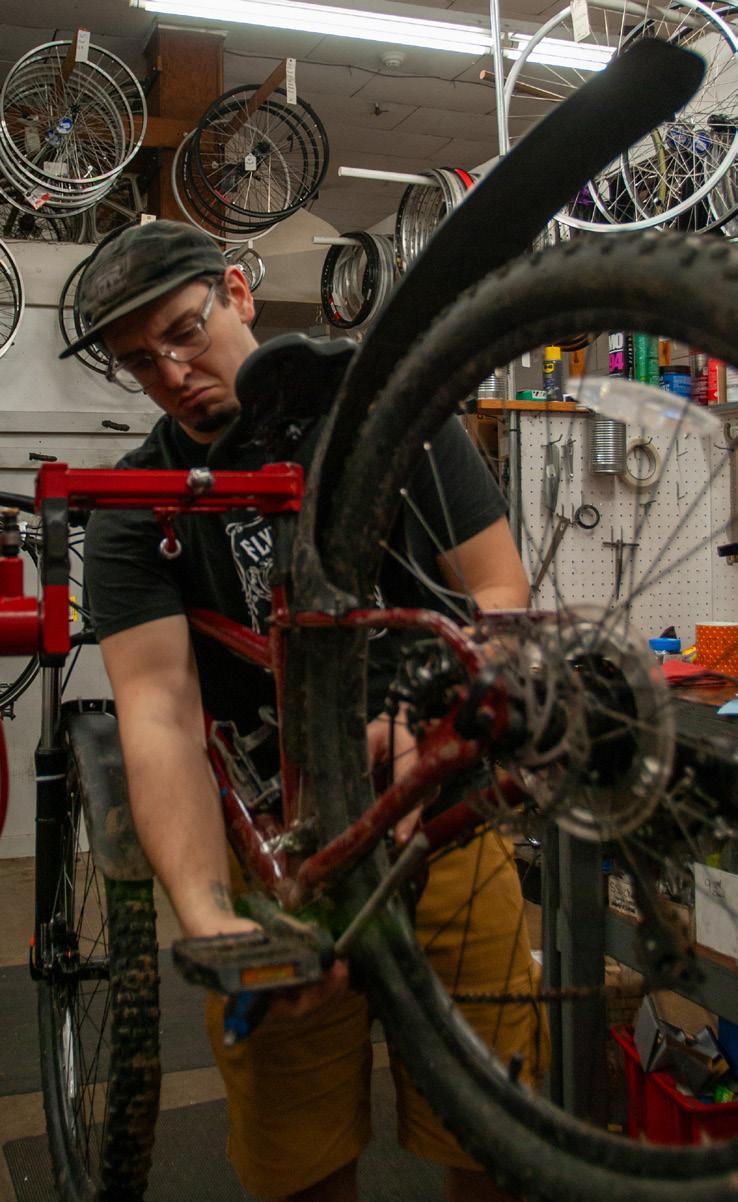
located on the corner of Second Street and Southwest Adams Avenue where I had the pleasure of meeting with Will Kratt. A quite charismatic cycle enthusiast who's been with the shop for the last 2 years. When he isn't in the shop repairing bikes, he spends his time riding them, weather permitted. Otherwise he is a bit of a gamer and spends time hanging out with his cat.
photos by BLAKE HOUSER⊳ Ronda Houser is a realtor for Caldwell Realty Group. She has been an agent for over two decades and at one point was the third highest grossing agent in the entire Willamette Valley. Ronda's philosophy has always been a "Client First" approach as she recognizes the challenges and concerns that go through someone's mind when they're looking to buy or sell their house. Ronda prides herself in being an active member and improving our community and is always happy to meet the new families moving into the valley and always goes out of her way to help them integrate into our little pacific paradise.
Ronda found herself attracted to real estate as a career goal. She spent over a year studying for the real estate board exam and was finally licensed in 2005. Ronda has partnered with several agents and brokers in the past and has used her extensive network to help get the job done quick and easy. Ronda says she never could have imagined doing anything different for her career and says she never gets tired of the work she does and the people she gets to meet. Every day is a new adventure for her and she loves the excitement that it brings.

▲ Alex Loveday, an event planner at the Student Leadership Council at Linn-Benton Community College, hosting an event on January 11. Alex enjoys organizing fun and engaging activities for the students and staff. He is in the coffee shop, where he set up a donut, plant, and book exchange. He is handing a donut to a happy participant, with a bright smile on his face. He is friendly, outgoing, and passionate about creating a positive campus culture.

▲ This is Chloe Davey. She is a business administration major here on campus and she enjoys rollerblading during her free time. The new big thing going on at the cafe is their new special the White Chocolate Raspberry Mocha which I can safely say is very delicious.
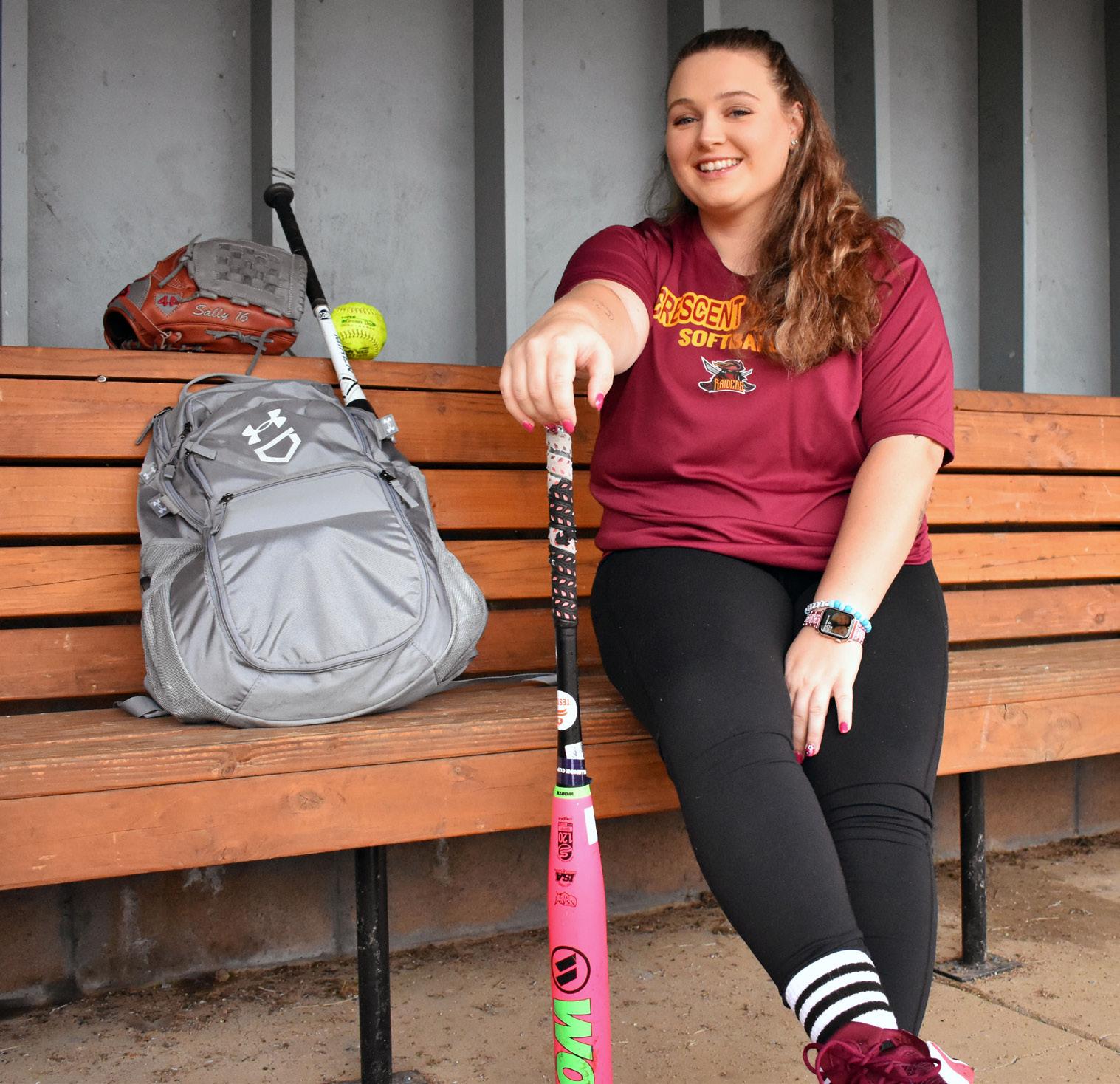
▲ Dani Sally, 23 years old, poses with her softball equipment in the Crescent Valley softball field dugout on February 5. Dani is a softball coach at CV and has coached for five years total, three of them being at the high school level. She has been playing softball for 16 years and still participates in tournaments in her spare time. When asked why she wanted to become a coach, she said "softball made me who I am today.

It taught me how to manage a schedule, self motivate, and self advocate. I want to give those lessons back to help shape other student athletes." Dani's favorite thing about coaching softball is watching athletes grow not only as athletes but as people at well. Outside of coaching, Dani regularly plays softball as well as participating in league bowling. She is working on her master's in accounting and currently works as a med tech in a county jail.

Students from Linn-Benton left a lasting impact on their community and earned volunteer credits by removing graffiti and clearing fallen branches from Waverly Park.
On Saturday, Feb. 3, LBCC’S Student Leadership Council partnered with the City of Albany’s Adopt-A-Park Program to clean up Waverly Park.
Both groups arrived at the Waverly Lake parking lot around 10 a.m. to set up before the volunteers arrived. The Student Leadership Council set up a table with a variety of black and blue T-shirts for volunteers, as well as coffee, donuts, and fresh fruit. The Adopt-A-Park Program, which is operated by the city’s Parks and Recreation Department, brought a trailer

full of rakes, shovels, wheelbarrows, gloves, graffiti-cleaning supplies, paint buckets, and many more materials.
Upon arriving at the park at 11 a.m. the Adopt-A-Park Program had students fill out a sheet with their information and volunteer hours. Student Life and Leadership Program Assistant, Amanda Mendell, recommended that students also log their volunteer hours on Noble Hour to earn benefits at LBCC. Serving 100 volunteer hours can earn LB students up to three paid tuition credits.
Around 10 student volunteers showed up to help between 11 a.m. and 1 p.m.
The students were assigned to help with picking up litter and fallen branches or to remove
graffiti. The majority of students went straight to work moving fallen branches and twigs out of the vivid green grass and into rustic wheelbarrows. Twigs and leaves were swept off the sidewalk. Volunteers then transferred everything into a heaping pile in the parking lot.
As he was moving piles of branches from underneath trees, SLC Executive Assistant Jack Hennum said he came because “I really like the SLC, and I think Peeta (Arenas-Galicia) the volunteer coordinator is doing a great job, so I wanted to help her out.” Hennum is majoring in political science and said he volunteered at one of the beach clean-ups a few terms ago.
Two other volunteers were assigned to remove graffiti from the tile walls of a tunnel that

leads into the park. For more than an hour, they used graffiti-removing spray and rags to scrub off the vandalism. Typically the Adopt-A-Park Program uses paint to cover graffiti because it’s less harmful to the environment, but the spray was more effective on the tile in this case. The park had multiple walls and tunnels that were covered in spray-painted markings.
Leighara Gottfried, one of the students scrubbing off graffiti, said she came to the event because she thought it was a cool opportunity to help out and get involved. Gottfried is a freshman majoring in mechatronics at LBCC.
When asked how the clean-up event first started, Mendell said the Student Leadership Council “officially adopted Waverly Park two years ago.”

According to Mendell, the SLC typically hosts a park clean-up once per term with a group of volunteers. “It’s a great way to connect the students with the community and make a direct impact,” she said.
As the program assistant, Mendell helps coordinate SLC events, sits in on the event task force and helps guide them, assists volunteers in a variety of ways, and works with clubs as an advisor.
The SLC coordinates the clean-up events and recruits volunteers each term, while the Adopt-A-Park Program provides the tools and cleaning supplies.
According to Adopt-A-Park Coordinator Jill Van Buren, there are currently 36 parks, trails, and natural areas within the city of Albany. Thirty-
three of these have been adopted by organizations, churches, or schools such as LBCC.
Adopting a park generally means volunteering some of your time to look after it, keep it clean, and help the wildlife thrive. According to the city, sometimes it simply means keeping an eye on it and reporting any problems to local authorities.
Van Buren has been a part of the AdoptA-Park Program for three years and has recently been working with two other volunteer groups, the Graffiti Chasers and the Diggers. She is passionate about removing graffiti and preserving the natural beauty of Albany’s parks and trails.
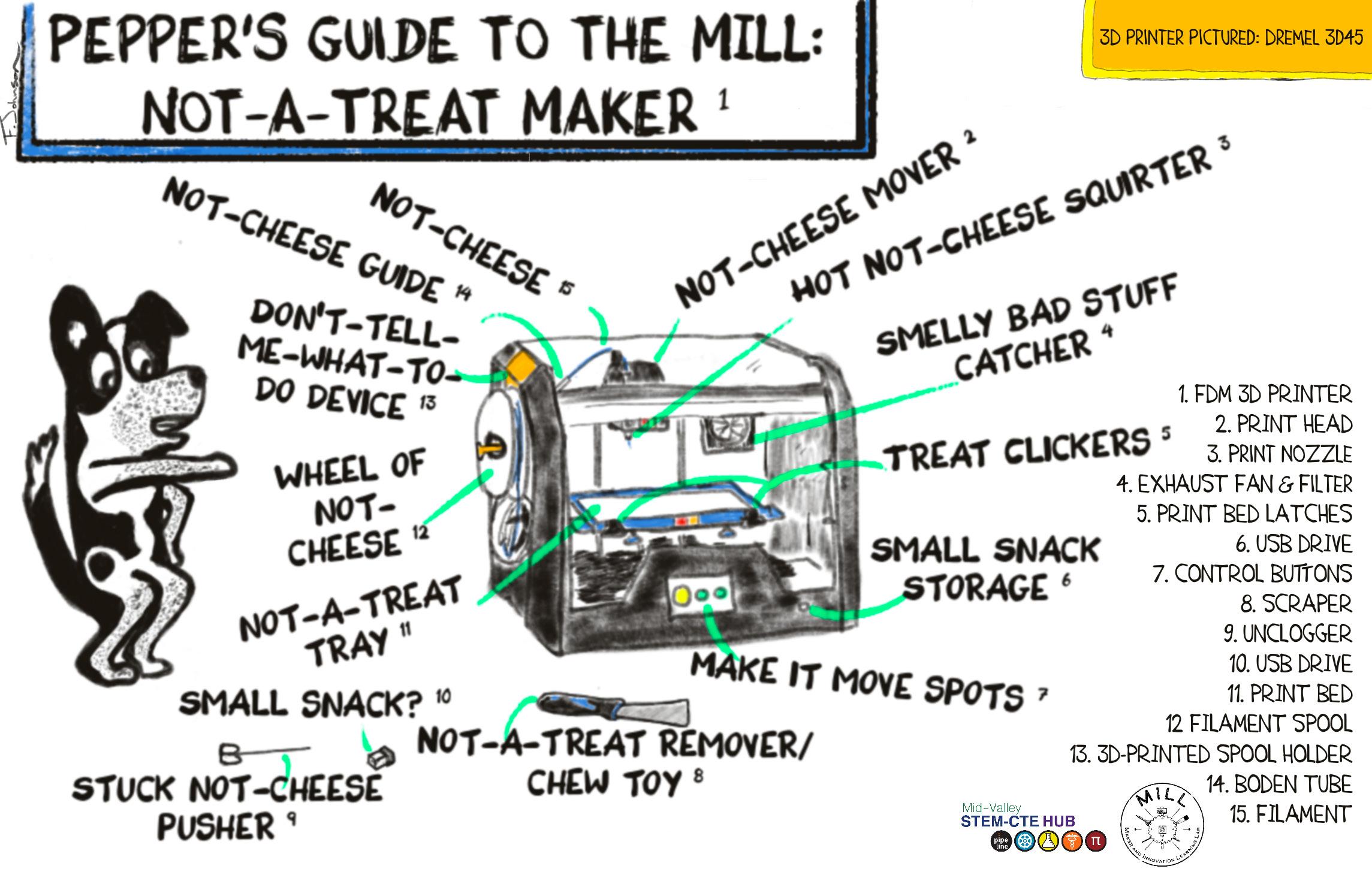


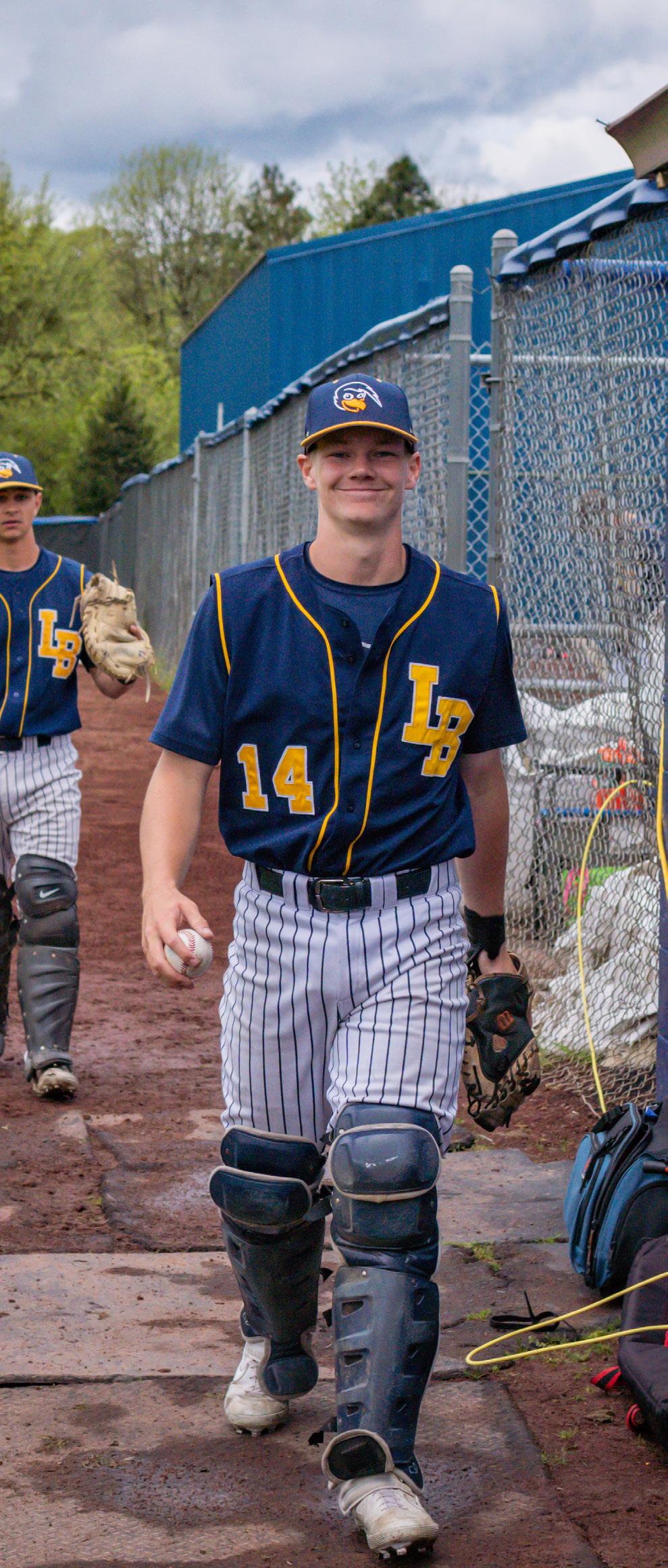
Arainout is typically a baseball player's worst nightmare. But in April 2022, now LBCC sophomore Ethan Buckley got the opportunity of a lifetime due to bad weather.
Buckley was born in Germany and raised in Cape Town, South Africa. Both of his parents were athletes as well and represented South Africa's national baseball and softball teams. He has loved the game since he first picked up a baseball around age 5.
His primary position has been catcher since he was 12 and since then he knew his dream was to play Division I college baseball in America.
He first came to the United States in 2018 to represent the South Africa U15 national team, and by the time he was 17 he started to put his name out to recruiters around the world.
In January 2022, Buckley and his childhood coach Tanner Leighton devised a plan to make his dream a reality.
Using a recruiting website, Buckley got the email addresses of about 60 coaches in the Northwest and directly contacted them for a tryout. Then, in April of 2022, Buckley flew more than 9,000 miles away from home to Boise, Idaho, where his former coach now lives. From there the plan was to drive from school to school trying out for each team.
His first week in America was spent working out and learning to drive on the right side of the road. He prepared for a long journey and had nine schools ready to give him a shot.
From Boise, Buckley set off to Clackamas Community College for his first tryout, then he had three other tryouts before coming to LB. At first it wasn't going to happen; LB had a game on the day Buckley could try out and he was going to miss his opportunity, but it got rained out. LBCC head coach Andy Peterson quickly contacted Buckley and invited him to a one-on-one workout.
“At other schools, I just joined in on the practice but this was a one on
one,” Buckley said. “He immediately wanted me on the team.”
Following the LB tryout, he finished his trip, hitting four more schools on his way back to Idaho. After 2,500 miles on the road, he visited nine schools in 10 days then had a decision to make, choosing the 2022 NWAC champions.
“I could have gone and played for practically all of them. LB gave me the best opportunity to develop.”
Buckley flew back home in May 2022 to prepare for his first year at LBCC. He got into contact with three of his new teammates to live with and on Sept. 8, 2022, moved to Albany. He started school and prepared for the 2023 season with his new team.
Assistant coach Griffin Williams also joined the team as a coach in 2023. He knew Buckley’s story and understood the kind of pressure he was under being so far from home and trying to accomplish his dream.
“We were all a little shocked,” Williams said. The team took it in stride though and Buckley found his footing quickly.
In the fourth game of the season, Buckley hit a home run that was a defining moment for him.
“Hey, I’m here and I fit in,'' Buckley said.
He went on to play 19 games in the 2023 season with a batting average of .311. The team finished 29-18 and won the NWAC South region that season.
Recently, during the 2023-24 winter break, Buckley’s former and current teammates, parents and coaches pooled money for Buckley to return home for Christmas for the first time since he moved to Oregon in September 2022.
“I'll forever be grateful for it,” Buckley said.
Now a sophomore, Buckley is looking forward to the 2024 season and is locked in on team success. “We're just focused on winning the NWAC.”
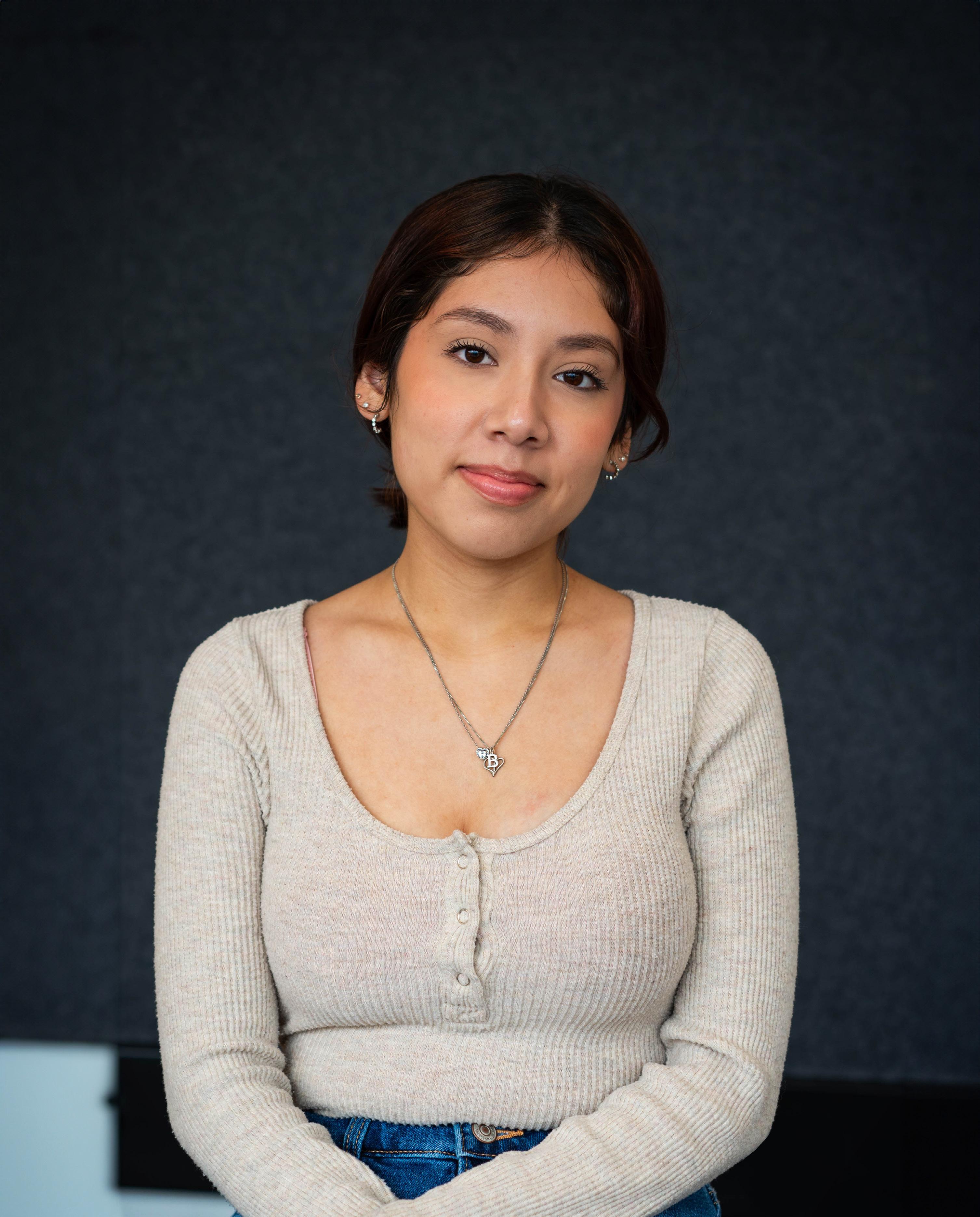

here’s more to just being the daughter of immigrant parents than one might think. It takes tough skin and a light heart. You're expected to be okay as you travel through your life. You’re expected to know how to travel through a strange country your parents know nothing about — having to smile at everyone when they ask how school’s going when you feel like screaming and ripping everyone’s head off, “It's good.”
The scorching hot questions, How are your grades? What are you going to study? What sports do you play? What college classes are you taking? What after-school activities are you doing? How are you involved? How many people do you know? Have you made friends? Acting like I know what I’m doing. The feeling of everyone's dreams piling onto you, weighing you down. The need for academic validation, the dream to be more than a field worker. Your parents look up to you seeing themselves in you, longing for their dreams to arise in you. You have no right to go off the path that they paved for you or you're seen as ungrateful. What about the dreams I long for? What about what I want? There’s nothing that I want, it's what they dreamed of. You learn to be grateful for even having the opportunity to grow up in the north.
Everything about el norte is a blessing, your family in Mexico expects you to be rich. You hear all the complaints that come from all around. Did you already forget about the poor? Why don’t you call anymore? When are you coming back? Can you send money? We need, We need, We need. What about what we need? They seem to forget I see my father struggle wanting to give us all he can while his family holds on to him like leeches sucking his money out, we are rich in their eyes. You're in the north you can’t be doing worse than them, don’t complain. They’ll never learn.
You learn to be a mother at a young age, you learn to properly clean the house just for your siblings to get it dirty in seconds, you learn to cook from spaghetti to tamales. You learn about finances. You learn how much your father makes to see if you’ll have enough to either pay for rent or food. You learn your father's pride causes your family to have to choose, he's too good for government money. You learn the feeling of your mother's weariness carrying down on you. You learn to shut up and to keep your mouth quiet while fighting arises in the house. You learn that being a kid comes and goes. You learn to grow up and try to fight to keep your sibling's childhoods going. You learn to translate at doctor's offices, schools, and supermarkets. If you don't know the translation “What do you go to school for?” you learn that if you don't work hard you'll “end up in the same
words by JANET HERNANDEZ photo by SARAH ROSE LARSONplace” as your parents. You learn to never let your parents down or your parent's struggle would've been for nothing. Your parent's struggle wasn't your choice but you can't be ungrateful. They give you everything and more. Your parent's hard work can be in vain so you try to accomplish everything they couldn't. Your parents see themselves in you, you can't let them down. You’re in the north you can't be doing worse than them, don't complain. They see themselves in you but not your struggle, to never disappoint, to never slip up, to never dream of your dreams if it isn't what they expected, to never be more than they want for you, but never be less. You become anxious about your parents' well being. Are they making enough money for the week? Are they okay? Are they happy with you? Are they proud of me? Are they okay at work? Are they having problems with anyone? You try not to worry too much or you'll go insane. You already have enough to worry about with home, family, friends, finances and school.
You go to school hoping to please everyone you come in contact with, making sure you participate in one way or another. You make sure you do your homework on time, you can't be a failure, you remind yourself of your parent's sweat and tears making their way across a border where they had to manage two worlds in their lives, and now you do too. You learn to read, write, and speak in Spanish and English, managing two cultures, your parents and the country you were born in. You manage both. Making sure you do it evenly, or you’ll end up preferring one more than the other. You have to learn to speak perfect Spanish and perfect English, you'll be the no sabo kid, the one whose native language is Spanish but hears English all around them.
One day we were in the car my dad was driving. His brown eyes glistened with the traffic lights, you see age creeping up with him, his gray highlights popping up. He hates them, he blames us for them. He was expressing to us how he felt ashamed that he couldn't give us more, he wanted to give us all he couldn't have. He reached a point in the conversation where he wanted to fully release all his emotions that were bundled up in his little kid heart. He just wanted to let it all out and be free from the cage he had learned to leave his emotions in. His wrinkles coming out, his anxiety, tiredness, he wants his mama. I see it in his eyes that he’s tired. I'll never fully understand why he never lets us know what is going on in there. To protect us? To seem machista? To seem like everything is in control? To show us he's strong? All I think about is if my mental health is dreadful, how is his? A boy who came into a country to be able to have a family and give them all their heart's desire.
EP: Drop 7 ARTIST: Little Simz PRODUCER: Jakwob OVERALL RATING: ★★★
review by RYLAND BICKLEYUK rapper Little Simz has been releasing music since 2010, building an audience and a critically-acclaimed back catalog before finally breaking into the mainstream with 2021’s 19-song album “Sometimes I Might Be Introvert.”
Interspersed between Little Simz’s grander, full-length albums have been her “Drop” series of EPs, more concise projects clocking in at well under 20 minutes that allow the artist to “drop” some songs to her fans without embarking on the rigorous creative process of creating an entire album.
Little Simz’s latest is “Drop 7,” her seventh such “Drop” EP that’s also seven tracks long and a mere 14 minutes and 52 seconds in length. The EP’s cover depicts Simz as a cyborg, foreshadowing the futuristic direction the project takes.
That modern feel is immediately apparent on the opener “Mood Swings,” built around pulsating, electronic drum loops. Simz even uses a touch of added reverb on the sibilance of the word “swings” to add another percussive element. Like much of the project to follow, “Mood Swings” is equal parts minimal and busy, with complicated, multi-layered beats almost entirely stripped of melody. Each drum track and sample is crisp and clear in the mix, with a range of different timbres to keep it interesting.
“Mood Swings” adds a burst of African drums in its pre-chorus, while “Fever” features a Latin element in its rhythm, with Little Simz even rapping a verse in Portuguese. The beat on “Torch” is a little more straightforward, built around a jittery high-end and a hard-hitting kick pattern. Subtle synth hits throughout bring a sense of depth, while an added hi-hat around a minute in completely changes the momentum of the beat.
“Torch” also highlights the versatility Little Simz brings to the table in terms of vocal delivery, with the rapper switching between a softspoken hook and focused, confident verses. Lyrics on “Torch” and the rest of the project reflect those of a rapper

who knows she’s made it (“If you know me I can bar for days / Nothing left to prove cause I’ve done enough, done enough”).
The following song, “SOS,” is the highlight of the record, incorporating all the elements present on “Drop 7” to create a three-minute house track filled to the brim with percussion loops. The vibe is so great that Little Simz lets it build for an entire minute and a half before finally entering, dropping a short, M.I.A-inspired verse with effectheavy vocals before letting the beat take over again. It’s the conclusion of a truly excellent four-song run to open the project, with each track fitting perfectly into the feel of the EP while still standing out individually.
However, the latter half of “Drop 7” loses some of its style and momentum. The perhaps aptly named “I Ain’t Feelin It” features a slow, unimaginative trap beat that isn’t anywhere near as exciting or energetic as what came before it. While Little Simz’s laid-back flow contrasted nicely with fast-paced beats before, here everything just sounds sleepy and uninspired.
“Power” brings back the energy, and Little Simz’s doubled vocals add an interesting element, but at just 55 seconds long it feels like a snippet rather than a fully-realized song. It abruptly ends before transitioning a little awkwardly to the closer “Far Away,” which starts off with wavy piano chords before a slightly muffled EDM backbeat comes in. The song features a solid vocal performance from Little Simz – her only time singing on the EP – bringing the project to a dreamy conclusion that still fits in with the percussion-heavy production of the project.
“Drop 7” isn’t anything revolutionary, but for the American ear that’s been oversaturated with trap music for the past decade, a world and dance-infused hip-hop record that still feels ultra-modern is a welcome change. At only 15 minutes, the EP’s low points don’t last long and its many highs are sharp, memorable, and worth a replay.

O Green World Gorillaz
“O Green World” by Gorillaz is a funky track from the Demon Days album that focuses on pollution and humanity’s impact on our green world. “O green world, Don’t desert me now, Made of you, and you of me, But where are we?”
TheCommuter


O Green World

















MOVIE: Bob Marley: One Love
DIRECTOR: Reinaldo Marcus Green
STARRING: Kingsley Ben-Adir, Lashana Lynch, James Norton
RATED: PG-13
OVERALL RATING: ★★★
Bob Marley: One Love is a clearly loving homage to one of the greatest and most timeless musicians in history. Though even with that it still stumbles into many of the same pitfalls that other music biopics land in.
The movie follows Bob Marley (Kingsley BenAdir) from his attempted assassination in 1976 to his historic One Love concert in 1978. Between these two events we get to follow him as he creates the landmark album “Exodus” and also through his diagnosis with cancer.
One of the things that really stood out while watching was the incredibly fast pace, which may leave you wanting more from the movie. The pace never really allows you to bask in a moment because by the time you start truly thinking about a scene a new one has started. It doesn’t really let you sit in the moment with Bob Marley, especially in emotional moments like his attempted assassination and diagnosis with cancer. Yet, this pacing doesn’t really inhibit the storytelling.
Obviously the movie being about Bob Marley means all of the songs are absolutely exquisite. The song choices from his pre- “Exodus” albums are always representative of the scene there and shows the incredible writing power of Bob Marley. The songs from “Exodus” that we get to see be written are also incredible and are sung well by Kingsley Ben-Adir.
The movie does allow for some great insight into his writing process and for anyone not incredibly familiar with him allows you to see the profound meaning in each of his songs. Yet, this insight mixed with the fast pace makes it feel like it almost focuses too much on the music and not enough on Bob Marley himself.
The performances are all amazing. Kingsley Ben-Adir nearly perfectly captures the vibe of Bob Marley with everything from his voice, mannerisms, and singing. Lashana Lynch is also a standout as Rita Marley and at many points acts as the emotional anchor for the movie. Finally, the entire supporting cast is amazing at holding up the leads and pushing the story forward.
Bob Marley: One Love, although fast paced, is still a good movie. If you love Bob Marley or even if you are completely unfamiliar with him this is an easy recommendation, especially because it is only 107 minutes long.
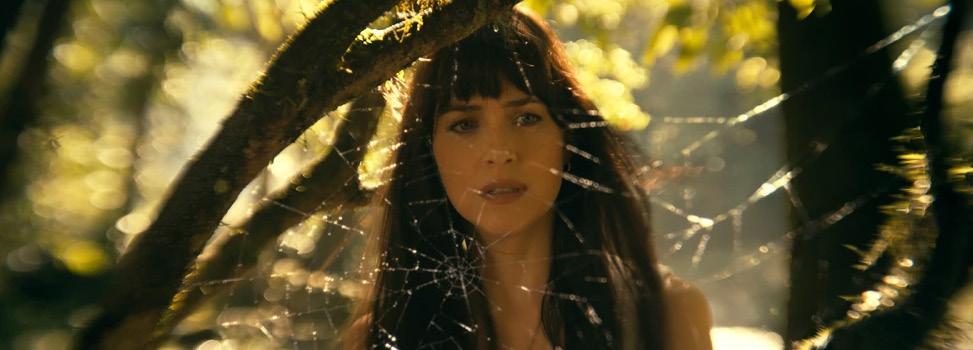




a Hilariously Messy, Tangled Spider-Man Spinoff
MOVIE: Madame Web
DIRECTOR: SJ Clarkson
STARRING: Dakota Johnson, Isabela Merced, Sydney Sweeney, Celeste O’Connor, Adam Scott and Tahar Rahim
RATED: PG-13
OVERALL RATING: ★★
Madame Web is the latest film in the Sony Spider-Man Universe. Loosely based on the comic character of the same name; this spinoff has more in common with 2022’s Morbius than any other film connected to Spider-Man.
After a prologue sequence set in the Amazon Jungles of Peru, the main story of the film takes place in the year 2003. As a young paramedic named Cassandra Webb (Dakota Johnson) discovers she has precognitive psychic powers; she must unite a team of aspiring superheroines to combat corrupt tycoon Ezekiel Sims (Tahar Rahim). The resulting 116-minute film recalls the comic book movies of the early 2000s setting in more ways than one; though not always for the better.
The plot from director and co-writer SJ Clarkson has leaps in logic that would rival the enhanced spiders found by the film’s cast. Scenes parallel horror stories such as Stephen King’s The Dead Zone and the Final Destination franchise, with the film’s serious moments providing some of the biggest doses of unintended humor. The setting has recognizable pop songs such as Britney Spears’ “Toxic,” Mystique’s “Scandalous” and No Doubt’s “Spiderwebs” among countless others, paired with a serviceable if unmemorable musical score from Johan Soderqvist (Let the Right One In.)
Though the cast does their best with what little they’re given (Adam Scott as a young Ben Parker is a standout), the script recalls a time
in superhero films where clear characterization and a coherent narrative were not necessarily guaranteed. Ezekiel Sims also lacks the imposing or memorable qualities of Spider-Man rogues such as Venom, Doctor Octopus or the Green Goblin.
Bearing the same $75 million budget as Morbius, this film also has lots in common with the aforementioned living vampire in terms of action and visual presentation. Sims’ costume appears to have been kit-bashed from Party City clearance items. The movie is full of CGI that resembles a PlayStation 2 game cutscene. The final battle at a fireworks plant (which features the most gratuitous of many Pepsi product placements in the film) has stunts and pyrotechnics that look less impressive than a given episode of Power Rangers, let alone the Spider-Man films it serves as a spinoff to.
While a sequel setup in the ending is unlikely to be followed (given how the film has the lowest opening weekend of any spinoff to date); Sony still plans to release a third Venom film in the fall and a spinoff centered around fan-favorite Kraven the Hunter in summer. Overall, while Madame Web may be well below the likes of Spider-Man: No Way Home and the animated Spider-Man: Across the Spider-Verse; it still tangles up a tale of messy hilarity for those who are curious enough to check it out.





39. Japanese hunting dog
43. Engage, as a security system
45. Lug along
47. O ering from Hertz or National
48. Ones who change employers often
52. In ___ (working in harmony)
53. Group artistically, as flowers
54. Have dinner
56. Brings up, as children
57. Lincoln or Vigoda
60. Cheese-covered chip
64. Costa ___ (Nicaragua neighbor)
65. Cry upon reaching port
67. Actress Barbara whose character was found by astronaut Anthony Nelson
68. Place to bowl
69. Green vegetable with tightly curled leaves
70. Mom's mate
71. Computer memory units
72. Places to get massages






